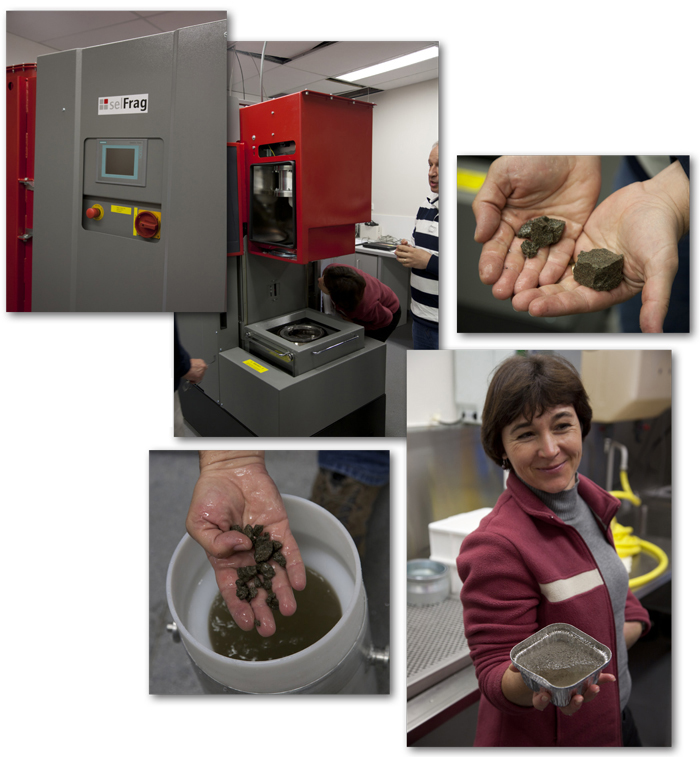Technology development program
BackgroundGEMOC's research, training and industry interaction programs require a high level of geochemical analytical technology, which is provided by the state-of-the-art facilities available to the Key Centre. Continual development of both technology and innovative analytical and microanalytical approaches is required to meet our research aims and the needs of our industry collaborators. GEMOC develops new analytical strategies as required, to determine the chemical and isotopic composition of geological materials (both solid and fluid) in solution and in situ. Special emphasis is placed on the development of advanced in situ microbeam methods. These developments are transmitted to industry via open and collaborative research, through technology exchange visits and workshops, and as an integral part of the training program. In 2009 a new strand of Technology Development commenced with the acquisition of a nucleus of a computer cluster for computational analysis, part of the strategic plan to develop strong capabilities in geodynamic and geophysical modelling. This new development is detailed below. |
The analytical instrumentation and support facilities of the Macquarie University Geochemical Analysis Unit (GAU) represent a state-of-the-art geochemical facility.
• The GAU contains:
- a Cameca SX-100 electron microprobe (installed January 2003)
- a Zeiss EVO MA15 Scanning electron microscope (installed January 2010)
- four Agilent 7500 ICPMS (industry collaboration; two installed October 2004; two installed May 2010)
- a custom-built UV laser microprobe, usable on the Agilent ICPMS
- five New Wave/Merchantek laser microprobes (two 266 nm, three 213 nm) for the MC-ICPMS and ICPMS laboratories (industry collaboration)
- a Nu Plasma multi-collector ICPMS
- a Nu Plasma high resolution multi-collector ICPMS
- a Thermo Finnigan Triton TIMS
- a Spectro XLAB2000 energy-dispersive XRF with rocker-furnace sample preparation equipment
- a LECO RC412 H2O-CO2 analyser
- an Ortec Alpha Particle counter
- a New Wave MicroMill micro-sampling apparatus
- a ThermoFisher iN10 FTIR microscope
- selFrag electrostatic rock disaggregation facility (installed 2010)
- clean labs and sampling facilities provide infrastructure for ICPMS, XRF and isotopic analyses of small and/or low-level samples
• Experimental petrology laboratories include 4 piston-cylinder presses (pressure to 4 GPa), hydrothermal apparatus, controlled atmosphere furnaces, Griggs apparatus and a multi-anvil apparatus for pressures to 27 GPa.
• The Centre for Isotope Studies has provided access to extraction lines and gas-source mass-spectrometers for stable-isotope analysis of fluids and minerals; it is planned that these facilities will be moved to GEMOC at Macquarie.
“The analytical instrumentation and support facilities of the Macquarie University Geochemical Analysis Unit (GAU) represent a state-of-the-art geochemical facility.”
THE GEMOC FACILITY FOR INTEGRATED MICROANALYSIS (FIM) AND MICRO GIS DEVELOPMENT
GEMOC is continuing to develop a unique, world-class geochemical facility, based on in situ imaging and microanalysis of trace elements and isotopic ratios in minerals, rocks and fluids. The Facility for Integrated Microanalysis now consists of four different types of analytical instrument, linked by a single sample positioning and referencing system to combine spot analysis with images of spatial variations in composition ("micro-GIS").All instruments in the FIM have been operating since mid-1999. Major instruments were replaced or upgraded in 2002-2004 through the $5.125 million DEST Infrastructure grant awarded to Macquarie University with the Universities of Newcastle, Sydney, Western Sydney and 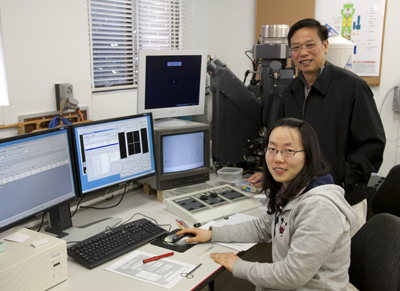 Wollongong as partners. In late 2009 GEMOC was awarded an ARC LIEF grant to integrate the two existing multi-collector inductively-coupled-plasma mass spectrometers (MC-ICPMS) with 3 new instruments: a femtosecond laser-ablation microprobe (LAM); a high-sensitivity magnetic-sector ICPMS; a quadrupole ICPMS. The quadrupole ICP-MS was purchased in 2010 and the other new equipment will be purchased and installed in 2011.
Wollongong as partners. In late 2009 GEMOC was awarded an ARC LIEF grant to integrate the two existing multi-collector inductively-coupled-plasma mass spectrometers (MC-ICPMS) with 3 new instruments: a femtosecond laser-ablation microprobe (LAM); a high-sensitivity magnetic-sector ICPMS; a quadrupole ICPMS. The quadrupole ICP-MS was purchased in 2010 and the other new equipment will be purchased and installed in 2011.
Co-tutelle PhD student Yao Yu at the EMP with her supervisor from Nanjing University, Xisheng Xu (a former GEMOC PhD).
the facility provides:
• The capability to image both major- and trace-element distribution in a sample, as an interpretive tool and as the basis for higher precision spot analysis of trace-element concentrations and isotopic ratios
• Co-registration of images and spot data from different instruments, and use of digitised images to locate spots with a precision of better than 5 µm
• Analytical capability for most elements of the periodic table at ppm to sub-ppb levels
• In situ isotopic-ratio measurement for a range of elements, at the precision required for geologically useful results
• New approaches to data interpretation through application of micro-GIS principles
Electron Microprobe: for imaging and point analysis of major and minor elements
Scanning Nuclear Microprobe: for imaging and point analysis of trace elements at ppm levels
Laser-ablation ICPMS Microprobes: for point analysis of a wide range of trace elements at low ppb levels
Multi-collector Sector ICPMS with laser microprobe: for high-precision in situ analysis of isotopic ratios
Micro-GIS system: A key aspect of the Facility is the co-registration of images and point analyses collected on all instruments. All data for a sample, from any of the instruments or from a bench microscope, are in the same coordinate system and can be overlaid in the computer to enhance interpretation.
When fully developed, images from one instrument will be read into the computer of another instrument and used to guide the analysis. Major-element maps from EMP, or trace-element maps f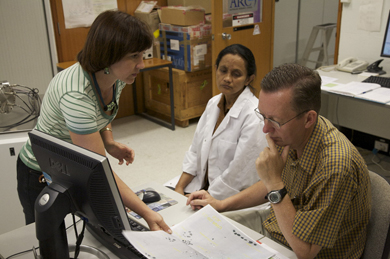 rom the nuclear microprobe, can be linked directly to images from petrographic or cathodoluminescence microscopes, BSE or SEM, or to spot analyses.
rom the nuclear microprobe, can be linked directly to images from petrographic or cathodoluminescence microscopes, BSE or SEM, or to spot analyses.
TerraneChron® Team - Elena Belousova, Ayesha Saeed and Norman Pearson.
CURRENT STATUS
Electron microprobe (EMP): In January 2010 the original EMP, a Cameca SX50 installed in 1993, was decommissioned and replaced with a Zeiss EVO MA15 Scanning Electron Microprobe. Prior to this the SX50 had been used mainly for the imaging and analysis of zircons, in connection with TerraneChron® applications and basic research. The Zeiss is configured with a cathodoluminescence detector and Bruker Energy Dispersive System. In early 2003 a new CAMECA SX100, with five crystal spectrometers and a PGT Energy Dispersive System, was installed. It is fitted with large-area diffracting crystals for improved sensitivity and lower limits of detection. The CAMECA SX100 carries the workload of the routine major and minor element analyses for the majority of GEMOC's research projects.
Scanning nuclear microprobe (SNMP): This instrument was built by Dr C.G. Ryan (with GEMOC funding contribution) as a separate beam line on the HIAF particle accelerator at CSIRO, North Ryde. The design incorporates several complementary types of detector, a new high-resolution probe-forming system and an innovative optical system, and provides both images of trace-element distribution and spot analyses, with a lateral resol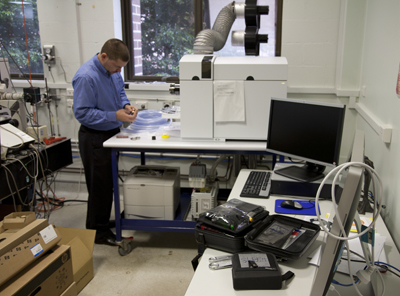 ution of 1-3 µm. Current capabilities cover micro-PIXE, micro-PIGE and quantitative element imaging. Due to the closure of CSIRO's North Ryde site during 2004, the SNMP beam line has been relocated to the accelerator facility at the University of Melbourne.
ution of 1-3 µm. Current capabilities cover micro-PIXE, micro-PIGE and quantitative element imaging. Due to the closure of CSIRO's North Ryde site during 2004, the SNMP beam line has been relocated to the accelerator facility at the University of Melbourne.
Installation of the new 7700CX ICP-MS.
Laser Ablation ICPMS microprobe (LAM-ICPMS):he original GEMOC LAM was installed in December 1994 using a Perkin-Elmer ELAN 5100 ICPMS (later replaced by an ELAN 6000), attached to a UV laser ablation microprobe built for GEMOC by Memorial University, Newfoundland. In 1999 the ELAN 5100 ICPMS was replaced by a Hewlett Packard 4500, and in 2000 an Agilent 7500S ICPMS was added. In 2004 two new Agilent 7500CS instruments were purchased (one primarily for solution work), and the 7500S replaced the HP4500 for zircon analysis at the end of the year. In 2010 two new Agilent 7700CX ICP-MS were purchased and one of them replaced the 7500S. This instrument is dedicated to in situ U-Pb analysis and joins one of the 7500CS instruments as part of the LAM-ICPMS stable. The 7500CS routinely provides quantitative 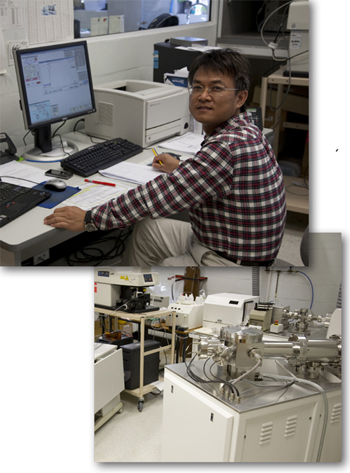 analyses of > 30 elements at sub-ppm levels in minerals, glasses and metals, as well as precise U-Pb dating of zircons. The laboratory currently uses three Nd:YAG LAM systems: a Quantel Brilliant laser that can deliver beams of either 266 nm or 213 nm light, a New Wave UP-266 nm system, and a New Wave UP-213 nm system. In October 2010 one of the UP-213 systems was upgraded with a New Wave Large Format sample cell, which has improved signal sensitivity and sample washout. In November 2005 the New Wave UP-193 nm system (based on a Lambda Physik OPTex excimer laser) was moved from the Nu Plasma to provide an additional option for in situ analysis of transparent minerals on the 7500CS. This has subsequently been decommissioned. Spatial resolution varies with the application, but typically is on the order of 30-40 µm. Each LAM is fitted with a computer-driven sample stage to provide co-registration of X-Y coordinates with the other instruments. On-line data reduction with the GEMOC-developed "GLITTER" (http://www.glitter-gemoc.com/) software enhances laboratory productivity and data interpretation; the software is marketed internationally through Access MQ.
analyses of > 30 elements at sub-ppm levels in minerals, glasses and metals, as well as precise U-Pb dating of zircons. The laboratory currently uses three Nd:YAG LAM systems: a Quantel Brilliant laser that can deliver beams of either 266 nm or 213 nm light, a New Wave UP-266 nm system, and a New Wave UP-213 nm system. In October 2010 one of the UP-213 systems was upgraded with a New Wave Large Format sample cell, which has improved signal sensitivity and sample washout. In November 2005 the New Wave UP-193 nm system (based on a Lambda Physik OPTex excimer laser) was moved from the Nu Plasma to provide an additional option for in situ analysis of transparent minerals on the 7500CS. This has subsequently been decommissioned. Spatial resolution varies with the application, but typically is on the order of 30-40 µm. Each LAM is fitted with a computer-driven sample stage to provide co-registration of X-Y coordinates with the other instruments. On-line data reduction with the GEMOC-developed "GLITTER" (http://www.glitter-gemoc.com/) software enhances laboratory productivity and data interpretation; the software is marketed internationally through Access MQ.
Our Long time collaborator Prof Jianping Zheng from China University of Geosciences (Wuhan), running Hf isotopes on the LAM-MC-ICPMS.
Laser Ablation Multi-collector ICPMS microprobe (LAM-MC-ICPMS): The Facility has two Nu Plasma MC-ICPMS. The first was installed in November 1998 and the other in November 2003. The second Nu Plasma instrument has high-resolution capabilities and a retardation filter to enable U-series work. The instruments combine a laser ablation micro-sampler, an Ar-plasma ionisation source, and a multi-collector magnetic-sector mass spectrometer, to provide high-precision in situ analysis of isotope ratios in geological materials. The instruments use either a New 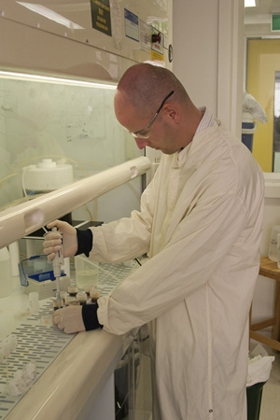 Wave UP-266 nm Nd:YAG laser, or a New Wave UP-213 nm Nd:YAG laser depending on the application. The MC-ICPMS also can be used in solution mode, with either a standard nebuliser or a desolvating nebuliser, to provide high-precision isotopic analysis of a wide range of elements, including many not accessible by standard thermal ionisation mass spectrometry.
Wave UP-266 nm Nd:YAG laser, or a New Wave UP-213 nm Nd:YAG laser depending on the application. The MC-ICPMS also can be used in solution mode, with either a standard nebuliser or a desolvating nebuliser, to provide high-precision isotopic analysis of a wide range of elements, including many not accessible by standard thermal ionisation mass spectrometry.
A Triton thermal ionisation mass spectrometer (TIMS): The Triton was purchased in 2004 following a successful ARC LIEF application led by Professor Simon Turner and Dr Bruce Schaefer (then at Monash University), and was installed in March 2005. Following an intensive period of testing the Triton quickly became the primary source of solution Sr, Nd and Os isotope analyses in the Facility, relieving the MC-ICPMS of this aspect of the workload. The instrument represents the state of the art in thermal ionisation mass spectrometry and its capabilities have contributed to the developments in Ra isotope analysis.
Felix Genske gowned-up in the clean labs.
Applications in use and under development include:
Laser Analysis (in situ point analysis)
• U-Pb geochronology of zircons from igneous and metamorphic rocks
• U-Pb dating of groundmass perovskite and xenocrystal rutile in kimberlites
• Hf isotope analysis in zircon and rutile for studies of crustal generation, mantle evolution and crust-mantle interaction
• Re-Os dating of sulfides in mantle-derived xenoliths
• Nd-isotope analysis in apatites, titanites and other REE-rich minerals, including kimberlitic perovskite
• Sr-isotope analysis of carbonates, feldspars, apatites, pyroxenes and kimberlitic perovskite
• Pb-isotope analysis of sulfides and silicates and perovskite
• Stable isotope ratios of Fe, Mg, Zn, Cu and other cations in appropriate minerals from ore systems and mantle rocks
• Multi-element trace element analysis of silicates, sulfides, oxides and diamond
Solution Analysis
• Re-Os — determination of mantle depletion ages and isochron ages in whole rocks, ilmenites and chromites; dating of sulfide assemblages in ore bodies
• Lu-Hf — crustal genesis, mantle metasomatism; Lu-Hf dating of garnet peridotites, eclogites, granulites; basalt genesis
• Rb-Sr, Sm-Nd, U-Pb, Pb-Pb — MC-ICPMS and TIMS
• U, Th-series analysis – for dating of young processes, ranging from magma genesis to weathering and erosion
• Multi-element analysis of trace elements in whole-rock samples
PROGRESS IN 2010
1. Facility for IntegratedMicroanalysis
a. Electron Microprobe: During 2008 the SX50 developed a range of problems and a decision was made in 2009 to decommission it. An order was placed for a Zeiss EVO MA15 SEM to carry the electron imaging workload and the installation of this instrument took place in January 2010. The Zeiss is configured with a cathodoluminescence detector and Bruker Energy Dispersive System, and since its installation it has provided high-resolution BSE and CL images for TerraneChron® and all other research projects. The SX100 serviced all projects including analysis of perovskite in kimberlites; analysis of platinum group minerals; minor and trace element analysis of metals.
Dan Howell imaging his diamonds on the Zeiss EVO MA15 SEM.
b. Laser-ablation ICPMS microprobe (LAM): During 2010, the LAM laboratory produced large volumes of data for fourteen Macquarie PhD thesis projects, several projects carried out by international visitors and Honours students, in-house funded research projects and industry collaborations. These projects included the analysis of trace elements in the minerals of mantle-derived rocks, in sulfide minerals and in a range of unusual matrices. As in recent years more than 7000 U-Pb analyses of zircons were carried out, related to projects (includingTerraneChron® applications) from Congo, Russia, Norway, Burkina Faso, Mongolia, China, Papua New Guinea, Indonesia, New Zealand, France, Ghana and Australia (NSW, SA, WA). The LAM laboratory also routinely provides data for projects related to mineral exploration (diamonds, base metals, Au) as a value-added service to the industry (see Research Highlights).
Until May, U-Pb dating of zircons was carried out on the Agilent 7500S and then on the new Agilent 7700CX. One of the two Agilent 7500CS instruments was dedicated to laser-probe applications, and the other set up for solution analysis. The continued operation of three ICP-MS has allowed uninterrupted periods of time for method development without disrupting the productivity of the laboratory.
c. MC-ICPMS: The rapid growth in the use of the TerraneChron® application (see Research Highlights and: http://gemoc.mq.edu.au/TerraneChron.html), coupled with the demand for in situ Re-Os analysis and stable isotope analysis, continued to produce severe competition for instrument time on the MC-ICPMS.
In 2005 significant advances were made in the analysis of 'non-traditional' stable isotopes and included the development of separation techniques and analytical protocols for Tl, Fe and Ni isotopes. In 2010 there was further development for the separation and analysis of Li isotopes and improvements in the analysis of U-series isotopes in rocks and groundwaters. Major applications during 2010 using in situ techniques continued to centre on the high-precision analysis of Hf in zircons to trace lithosphere evolution and magma-mixing histories in granitic rocks, and Re-Os dating of single grains of Fe-Ni sulfides and alloys in mantle-derived rocks. In situ Hf isotopes were measured in zircons from Australia, Congo, Russia, Norway, Burkina Faso, Mongolia, China, Papua New Guinea, Indonesia, New Zealand, Brazil, Columbia, Chile, Sweden, France and Ghana. We carried out Re-Os studies on xenoliths from the USA, South Africa, northern Africa, eastern China and Siberia. Sr and Nd isotopes were measured in situ in kimberlitic perovskites from South Africa.
d. Laboratory development: The new clean-room facility, which is being used primarily for isotope separations, opened in April 2004. It provides an ultra-clean environment within a 3-stage pressurised volume; it contains 6 Class 3500 work areas, three for radioactive isotopes and three for other activities.
e. Software: GLITTER (GEMOC Laser ICPMS Total Trace Element Reduction) software is our on-line interactive program for quantitative trace element and isotopic analysis and features dynamically linked graphics and analysis tables. This package provides the first real-time interactive data reduction for LAM-ICPMS analysis, allowing inspection and evaluation of each result before the next analysis spot is chosen. Its capabilities include the on-line reduction of U-Pb data. The use of GLITTER has greatly increased both the flexibility of analysis and the productivity of the laboratory. An arrangement by which New Wave Research marketed the software together with their laser microprobe equipment was terminated late in 2007. Sales are now handled by Access MQ (formerly Macquarie Research Limited) and GEMOC provides customer service and backup. During 2010 a further 22 full licences of GLITTER were sold bringing the total number in use to 171 worldwide, in forensics and materials science, as well as earth science applications. During 2005, Will Powell, Norm Pearson and Chris Ryan began updating GLITTER to version 4.4 and version 4.4.3 is currently available without charge to existing customers and accompanies all new orders. Will Powell continued in his role in GLITTER technical support and software development through 2010.
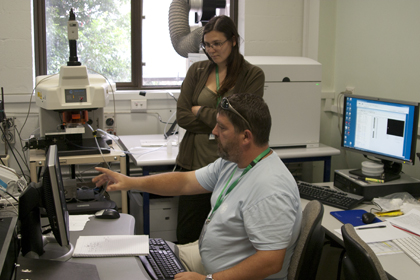
Olivier Alard of the University of Montpellier (a former GEMOC PhD) showing his PhD student Jennifer Chaufard the ropes in the LAM-ICPMS lab.
2. Laser development
For more than a decade GEMOC benefited from an industry partnership with New Wave Research (formerly Merchantek EO), a major US manufacturer of laser ablation systems. The mobility of the probes has allowed them to be used on both the quadrupole ICPMS and MC-ICPMS instruments, in a range of applications. A Merchantek/New Wave Research 193 nm excimer system based on a Lambda Physik OPTex laser, delivered in March 2002 was decommissioned in 2009. Three more New Wave laser systems, acquired during 2004 (a UP-266 nm and two UP-213 nm), represented a major upgrading of the instrument park and giving redundancy to limit downtime. The 213 nm lasers are now used for most of the zircon analytical work including both U-Pb and Hf isotope analyses, especially where small grains are being analysed. The 266 nm systems have proven most useful for analysis of sulfides, and for other stable-isotope applications.
3. Energy dispersive XRF
A Spectro XLAB2000 energy-dispersive X-ray spectrometer, installed in November 2000 in a joint venture with Tasman Resources, produces high-quality major- and trace-element data. Following resolution of a series of problems in 2008, the XLAB2000 returned to full operation in 2009
A LECO RC412 H2O-CO2 analyser, installed in September 2003 to replace an outdated unit, is providing high-quality analyses to complete whole-rock analyses by XRF and solution-ICPMS.
4. Solution analysis
An Agilent 7500CS ICPMS is regularly used to provide trace-element analyses of dissolved rock samples for the projects of GEMOC researchers and students and external users, supplementing the data from the XRF.
The in situ analysis of the Rb-Sr, Lu-Hf, Sm-Nd and Re-Os systems by laser ablation microprobe has required the development of corrections for isobaric overlaps (e.g. 87Rb on 87Sr), and has demonstrated that these corrections can be done with very high precision in the Nu Plasma MC-ICPMS. This has allowed us to simplify the ion-exchange chemistry traditionally used to obtain clean element separations for standard mass-spectrometry analysis. A new scheme was developed for the dissolution of rocks and mineral separates, to enable the separation of Sr, Nd and Hf from the same sample digestion. Prior to the installation of the Triton TIMS the isotopic analyses were performed using the MC-ICPMS in solution mode. Subsequently the analysis of Sr and Nd has been moved on to the Triton but Hf continues to be run on the MC-ICPMS. An additional clean-up column has also been added to the Nd separation method to remove Ba and LREE from samples with LREE-enriched compositions. This step has been found to be necessary in order to run these samples on either the MC-ICPMS or TIMS.
During 2010 further developments were made in the separation of 'non-traditional' isotopes, with significant improvements in the separation of Li and Mg from silicate rocks. The permanent availability of one of the Agilent 7500CS for solution analysis greatly benefited the development of the separation techniques. Advances were also made in the U-series chemistry with the development of separation methods for Ra and210Pb.
5. Diamond preparation and analysis
In 2008 Argyle diamonds donated to GEMOC a laser-cutting installation, which allows us to cut thin plates of single diamond crystals, allowing detailed spatial analysis of trace elements, isotopic ratios and the abundance and aggregation state of nitrogen. Refurbishment of the laboratory to house the laser cutter was completed in late 2009 and installation of the equipment took place in early 2010. GEMOC also took delivery of a new-generation FTIR microscope, the ThermoFisher iN10. This allows the spatial mapping of whole diamond plates at high resolution with very short acquisition times (see Research Highlights).
6. SelFrag – a new approach to sample preparation
GEMOC's new selFrag installation was finally in place in 2010 - and Elena Belousova clearly was pleased with its behaviour.
The first selFrag instrument in Australia was installed in GEMOC in May 2010. This instrument uses high-powered electrical pulses to disaggregate rocks and other materials along the grain boundaries. It removes the need to crush rocks for mineral separation, and provides a higher proportion of unbroken grains of trace minerals such as zircon. Since its installation selFrag has been used for a range of applications including zircon separation, the analysis of grain size and shape in complex rocks, and the liberation of trace minerals from a range of mantle-derived and crustal rocks.
7. Computer cluster
A new 64-core computer cluster (Enki) came online in 2010, with the capability to run massively parallel high-resolution geodynamics simulations in 3D at a global scale. The cluster is running some of the most cutting-edge simulation software packages, including CitcomS – enabling 3D spherical mantle simulations, and Underworld – a lithosphere and mantle deformation computational framework designed for massively parallel simulations. It has supported two Honours student projects, as well as two ongoing PhD projects, and underpins at least two successful ARC Discovery projects. Further funding obtained in 2010 will be used to expand the cluster into a 96+ core machine within the next year.

 GEMOC ARC National Key Centre
GEMOC ARC National Key Centre
